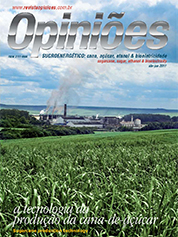Luciano Rodrigues
Agroindustrial Expert Engineer at CTC
Op-AA-28
Harvesting and transporting seed sugarcane: focus on quality
When talking about mechanical planting of sugar-cane, one immediately thinks of operations inherent to the last phase of this process that takes place in the planting process, often disregarding all other operations involved. Among such operations, harvesting and transporting seed cane stand out, since they directly impact cost and quality of the material propagated.
It is important to point out that the concept of harvesting seed cane is different from the concept of harvesting cane for crushing, whose focus is productivity with no loss in quality (mineral and plant impurities), whereas in harvesting seed cane, the focus is on quality (growth and vigorousness), with no loss in productivity.
Mechanical harvesting is a physical contact intensive process between mechanical parts of a machine and plant tissue, which needs to be systematically monitored to minimize damage to the material to be propagated. This involves complex interacting between engineering and biology, from which one seeks to extract a machine’s best performance, without compromising plant development.
To assess the impact of mechanization on sugarcane planting, one starts out with manual planting as the basis, in which sugarcane stalks are cut manually and also planted manually. Usually, this planting system uses from 10 to 12 tons of seed cane per hectare. In mechanical planting, on the other hand, one uses approximately 18 to 22 tons of seed cane, whose planting is done mechanically by billet planters.
This represents a 100% increase in the quantity of seed cane used, thereby greatly increasing the cost of this operation, given that seed cane represents approximately 30 to 40% of the total cost of planting. What is the reason for planting more seed cane in the mechanical system than in the manual one? Is it only because of the damage caused the bud, which is the structure of the billet that actually generates a new plant? The answer is not that simple.
Assuming that the average of buds damaged in mechanical planting is about 10%, it would make sense to plant 10% more buds, i.e., to increase the quantity of seed cane from 12 to 13.2 tons per hectare.
Apart from the planter equipment’s dosage reliability that still needs to be improved, the response for a 100% increase in the quantity of seed cane consists in reducing the bud shooting rate because of damage to the billets’ physiological system, resulting from mechanical operations, mainly during harvesting. This damage can be minimal and go unnoticed, but sufficient to adversely interfere in buds’ physiological process.
Depending on the extent of damage, the result may vary from a reduction in resistance to stress in the environment, such as hydric deficit or low temperature, and may actually even prevent a new plant from being generated. Currently, there are no harvesters developed specifically for harvesting seed cane, so conventional machines need to be adapted. According to industry estimates, in 2015, 1,000 seed cane harvesters will be needed, therefore meriting more attention to this type of equipment.
Even with recent improvements made to these harvesters, the achieved quality gains are incremental and the industry is in need of a technological leap concerning this operation, which represents additional effort in diminishing cost increases in agricultural production. The expansion of mechanically planted areas will increase the need for bin tractors.
The influence of this kind of equipment on seed cane quality is less in comparison with the harvester, however, one must pay special attention to using this type of equipment for harvesting. To optimize seed cane transportation in situations in which the nursery is far from the plantation, one must use high-speed bin vehicles equipped with road tires.
Once in the harvesting area, these vehicles cause severe damage to the crop because of trampling on ratoons and soil compacting. Replacing high fluctuation road tires with low pressure tires diminishes the compacting problem, but does not eliminate trampling on ratoons.
An alternative is to use bin vehicles coupled with tractors with properly sized gauges for transferring seed cane just harvested to a vehicle equipped with road tires. Mechanical planting is still an engineering challenge, but it is a system that will shortly be used in most sugarcane planting areas, due to both the lack of labor and the need to reduce costs and improve sugarcane plantations.
Notwithstanding current difficulties, using adequate equipment for harvesting, transporting and planting, along with good planning of plantation reformation, will surely result in a more viable alternative from the point of view of logistics, economics and strategy for the sugarcanebased industry.
In this context, investment in research and development is essential so as to not miss the timing in this process and be taken by surprise in future with low performance equipment that does not meet, or fully meet, profit expectations of the sugarcane-based industry.




